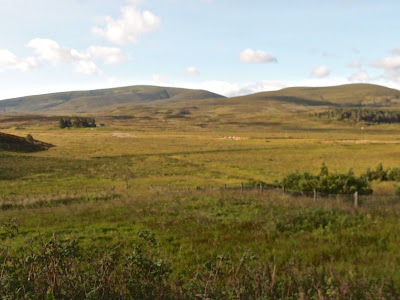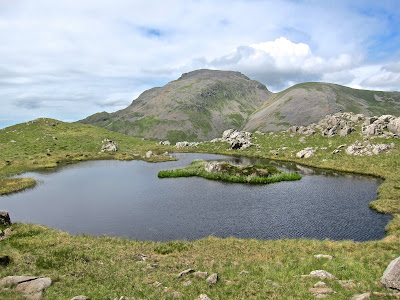 |
Loch Hourn and Beinn Sgriol from the summit of Ladhar Bheinn
|
The fourth round of Munros was a feast of crazy walks and this became more frenzied as I realised that I might be able to finish them in less than 4 years and in 80 days of walking. I decided to push for the biggest walk of them all. The three Munros in Knoydart are usually done over a couple of days from Inverey or from the bothy or camp at Barrisdale. The latter usually requires an extra half day to walk in and out from Kinloch Hourn. By late September there were limited daylight hours and this was probably the last chance to bag them this year.
I had little difficulty persuading Mark to attempt them as a single day walk, he had accompanied me on many recent epic days in the hills and knew it would be another 'finish in the dark walk'. Mark is thirteen years my junior and walks huge distances every weekend, he had already completed well over 2000 Munros to my 1200 at the time we did this walk. He made my average of 60 to 70 Munros a year seem modest as he regularly went over the ton and had achieved 200 in a year. Although my speed on the ascents had slowed as I approached 60, I tended to get stronger and more determined as the day progressed. We had already completed a handful of 12-hour walks in the summer but the Rough Bounds including the walk in and out from Kinloch Hourn in a day was still a big ask. The SMC had described the walk in and out and the ascent of Ladhar Bheinn as only for the very fit walkers and we planned to add Luinne Bheinn and Meall Bhuidhe into the mix.
 |
| Luinne Bheinn summit ridge |
 |
| Between Luinne Bheinn and Meall Buidhe - not recommended in claggy weather |
 |
| Rhum from Meall Bhuidhe |
 |
| Ladhar Beinn summit ridge |
 |
| Ladhar Beinn summit at 6pm |
 |
| Beinn Sgriol from Ladhar Bheinn |
 |
| Loch Hourn from Ladhar Bheinn |
Saturday 29 September 2007
Ascent: 3150 metres
Distance: 45 kilometres
Time: 17 hours 50 minutes
Luinne Bheinn 939m 4hrs 44mins
East top 937m 4hrs 57mins
Meall Bhuidhe s.e. top 942m 6hrs 44mins
Meall Bhuidhe 946m 6hrs 52mins
Ladhar Bheinn 1020m 11hrs 13mins
Stob a' Choire Odhar 960m 11hrs 38mins
We left work at 5:30pm on a Friday and drove to Fort William where we ate a cheap and quick meal in Morrison's before the long drive to Kinlochhourn. I had booked into a self-catering flat to avoid having to faff about taking tents down in the morning. We arrived at the flat and packed our rucksacks for the morning just before the generator switched off at 11pm so we turned in. We were up by 6am and away by 6:35am, we dumped anything we didn't need into the boot of the car and drove a couple of hundred metres to the car park at the start of the coastal path. The day was dry with a layer of cloud and a cool breeze and we soon dropped into an easy rhythm as we followed the roller coaster of a path that leads to Barrisdale, I had camped along the path once and woken to the spectacular morning views across Loch Hourn. The cottage opposite at Caolasmor was in the sun and seemed an idyllic location although 4 miles from the nearest road, I even had a foolish notion to buy and renovate it as a retirement house.
We had to traverse over the two hills on the path to Barrisdale: Skaraval and Runival. In the way that these things go, we called them little bastards and thereafter named them Bernie and Eccleston. We had realised that they would be real killers as we headed back late in the evening. After just over two hours walking we dropped down to Barrisdale Bay, the skies were clearing and Ladhar Bheinn hove into view. We reached the bothy and met one of the stalkers and checked that our route for the day did not conflict with any shooting. We decided to tackle Luinne Bheinn first and save Ladhar Bheinn for the evening when we hoped the light would have improved. Then began the long path leading to Mam Barrisdale from where we headed for Luinne Bheinn.
We made good progress to Mam Barrisadale before having to head south-east and begin the steep northern slopes of Bachd Mhic nan Tosaich. We caught a party of 4 younger climbers who seemed surprised that a couple of scruffy middle-aged men could overtake them. Mark was flying up the hill ahead of me, attired in his usual outfit of hand knitted pullover, old running trainers, a cheap rucksack with a Tesco bag holding his waterproofs tied on top. As I passed the foursome they enquired about the sanity of 'Tesco man' and seemed concerned that he was not equipped for Luinne Bheinn. When I told them that we intended to walk all three Munros they shook their heads in disbelief; we looked as if we were equipped from a charity shop and Mark probably was.
We arrived at the summit of Luinne Bheinn just before 11:30am and gave ourselves a short break before starting the long walk along the undulating ridge towards Meall Bhuidhe. This is no place to be in poor visibility but there is a discernible path that twists and turns through the rough rock outcrops. I stopped for a chat with a couple and then began the long pursuit of Mark who doesn't entertain stopping on long walks. I was in no real hurry at this stage of the day and began to enjoy the sea views over to Skye, Rum and the small isles. Meall Bhuidhe was reached by 1:30pm where there was a large group of younger walkers from Inverey who seemed more concerned with making phone calls boasting that they had made it rather than admiring the view. I thought about venting my feeling about the inappropriate use of mobile phones but decided to devote my angst to making light of my lunch instead.
We began by retracing our steps back along the ridge before dropping down to Coire Odhair and traversing below Luinnhe Bheinn to reach the bealach at Mam Barrisdale. It is a good route that I have used on three other occasions including one trip when we camped in the coire. The real test of the day comes next, the 400-metre ascent from Mam Barrisdale to the 849 metre western top of the Stob a' Chearcaill ridge. It is always a long slog up unforgiving deep grass usually at the time of day, mid-afternoon, when energy levels are at their lowest.
With this in mind, we had a break and took on board some more food. The climb was no exception to my previous experiences but the reward as we reached the 849 metre top was magnificent. We were at the start of the wonderful ridge that leads across to Ladhar Bheinn. There was some late afternoon sunshine and blue skies ahead with views of the coast, Beinn Sgriol and behind us was the complex topography of deepest Knoydart. This is a sublime walk and despite the ups and downs of the ridge, the tantalising prospect of Ladhar Bheinn dissolved any tiredness.
The summit was reached at 6pm and Mark declared that he was not going to move until he had enjoyed the idyllic views from the summit. It gave us chance to grasp the perfection of the scenery and we had difficulty bringing ourselves to leave after 15 minutes. Time was tight and we wanted to be off the hill at nightfall, which was about 7:30pm. We descended the northeast ridge to Stob a' Choire Odhair and then dropped into the shadows of Coire Dherrcail. It was time to get a move on and we crossed the river and found a path leading down to Barrisdale. The path was engulfed in bracken and made for a difficult and steep descent and we had to put on our head torches before reaching the tidal flats.
The tide was in and in the gloom of the evening Mark managed to step into one of the braided streams, he was waist deep in sea water. The route across the tidal flats to the bothy was an exercise in avoiding any more accidental soakings and took over half an hour. I had managed to strike a better route and arrived at the bothy a few minutes before Mark. I was assailed by the climbers from this morning "where have you left Tesco man, does he need help?" I was able to say no, he would be here soon and a towel and a drink would be all that he needed.
We topped up with water and finished our sandwiches and then announced that we were heading back to Kinloch Hourn. It was almost 9pm and the climbers thought we were crazy to attempt the walk out in the dark. So we were but it was meant to be a day walk so we tramped off in search of Bernie and Eccleston. The moon gave us some help after my head torch called it a day and that assisted us as we followed the path out. We cursed Eccleston before venting our most vindictive vocabulary on little Bernie, which seemed to have grown in the light of the silvery moon.
We arrived at the car shortly after midnight, a record late finish even for us, the previous best was a bivvy at 11:30pm near the summit of Carn Dearg by Ben Alder after deciding to flee the midges in the glen below. After stripping off minging clothes and removing wet shoes we changed into more comfortable attire and began the long drive home. At the foot of the road out of Kinloch Hourn, we followed a badger that sashayed its way up the road in front of us looking resplendent in the headlights until it headed off into the wild after crossing the bridge.
The journey home was mainly an exercise in staying awake, I drove for the first hour until we reached the main road and invited Mark to drive to beyond Fort William whilst I took a nap. I took over for another hour and Mark had another stint before reaching Callander at 4am, I eventually made it home by 4:30am. I fell into a deep sleep and was awakened at 10am by my son telling me that I am getting a bit too old to be staying out that late. He was right of course but I had achieved another big walk and round 4 of the Munros was almost in the bag.










































